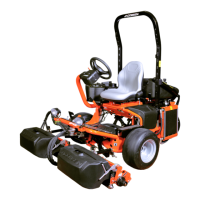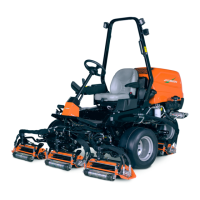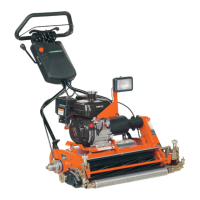HYDROSTATIC POWER TRAIN
4181383 First Edition 5-25
5
!
WARNING
IMPORTANT
It is important to lift and support the machine or the
machine will move.
3. Lift the machine so that front and rear wheels are off
the ground and support with stands.
Figure 5-24
4. Install test hose between ports (1 and 2).
5. Install pressure gauges to the system pressure
gauge ports (3 and 4).
NOTE
Verify engine rpm is within specification (2850 rpm ± 50)
to ensure accurate hydraulic test results.
6. Start engine, release brake, and run at full throttle
(2850 rpm ± 50).
7. Operate hydraulic system until oil temperature is at
120—150°F (49—65°C).
Figure 5-25
8. Loosen servo lock nut (5) while holding the servo
adjustment screw (6) in position.
9. Turn servo adjustment screw (6) until the two system
pressure gauge readings are equal.
10. Turn servo adjustment screw (6) clockwise until one
of the system pressures starts to increase.
11. Noting the amount of rotation, turn servo adjustment
screw (6) counterclockwise until the other system
pressure starts to increase.
12. Turn servo adjustment screw (6) clockwise half the
amount of rotation noted earlier.
13. While holding servo adjustment screw (6) from
turning, tighten servo lock nut (5) to 15 ± 3 lb-ft
(20 ±4
N·m).
14. Stop the engine and apply brake.
15. Remove pressure gauges from ports (3 and 4) and
remove hose between ports (1 and 2).
16. Adjust transmission neutral (creep). (See “Adjust
Transmission Neutral (Creep)” on page 5-10.)
Prevent personal injury. Use properly rated lifting
devices. Always be sure load is balanced before
lifting.
Support the machine properly using jack stands.
TN1398
1
2
3
4
TN1397
5
6

